|
|
|
|
When Viola, my mother, and Charles Richard, my father's, third child was born we
had moved to Eldorado, Arkansas, where my father worked as a mechanic in an oil field. The baby was
a boy and they named him Charles Richard (Dick )Edgar Jr. My mother didn't receive the proper care when the baby
was born and so she had blood poisoning. She grew weaker and weaker and could not care for herself or the baby. I remembers
trying to help my mother. I would wash the baby's clothes in my little blue and orange toy tub.
My father called Granny and told her that my mother was very ill. When Granny
found out about her daughter's condition she took a train to Eldorado. I'm sure Dad
was half-crazy with two little girls, a baby and a sick wife. When Granny arrived in El Dorado, there was nothing she
could do to help Mother as the blood poison was so bad. She got her up and took Mother, the baby, my sister,
Mary, myself and my Dad to Dallas by train. I remember getting a lot of attention from the people on
the train. They felt sorry for the sick lady with two small children and a baby. When we arrived in Dallas Granny
and my Dad took mother straight to the hospital, but she didn't live very long. She died March 16, 1923 and was buried
in Grove Hill Cemetery in Dallas, Texas. Granny said that if Charles had brought Viola home to have the baby, as he had done
before, she could have taken care of her and she wouldn't have died. That is probably true but we can't go back and change
the things that life deals us.
After Mother Viola's death my father took me, Vivian, Mary Louise and Dick to
Los Angeles to live with his mother. Sometimes we lived with his sister Betty. We called her Aunt Betty and
she lived in Portland, Oregon. About a year after Mother died Dad remarried. He married a woman named Andrine
'Ann'. About a year after they were married, they had a daughter and named her Joy Colleen. For a time my
sister, Mary Louise, and I moved back and forth from Dallas to Los Angeles and to Portland.
Dad and Ann were Catholic and thought we should attend a Catholic school. This really
displeased Granny, so she asked Charles if the children could live with her. Charles agreed, so in August 1925 Dad brought Mary
Louise and me to Granny. I was seven and a half and Mary Louise was five and a half. The first few years
after we went to live with Granny, Dad and Aunt Betty visited us and took us in the summer but then the depression
came in the early thirties and we didn't see them very much. So we stayed with Granny until we were grown.
|
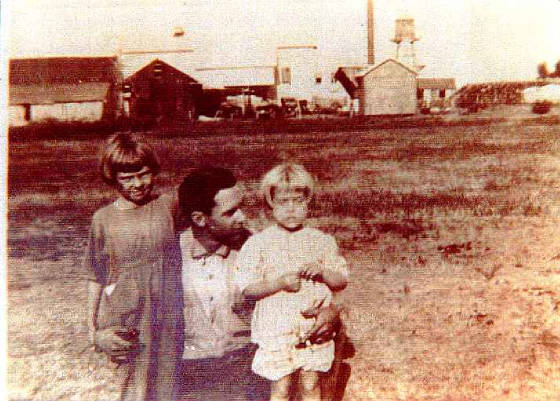
Charles Richard and his two daughters: Vivian left, and Mary right. This picture was taken in 1925
in Granny Kate's yard, the year Daddy brought us to live with her. Could he be telling us good-bye?
The
cotton gin is behind them. Back then the gin was run by a steam engine. You can see the water tower that held water for the
boiler.
We girls liked living with Granny. We loved our aunts, Red and Naomi, and our
Uncle Tom who was now seventeen years old. By now James Allen (Uncle Jim) had married and left home. His wife was named Vella,
we called her Aunt Vella.
I missed my father very much, and Uncle Tom kind of took his place. I could always
count on him to fix broken things or for a little school money. He became my idol; he was kind, patient and gentle with
me. Uncle Tom had a lot of curiosity, and wanted to know how things worked. He could usually figure it out and could
duplicate things if he had the right materials. He made a lot of things for us kids to play with.
I remember Uncle Tom making a crystal set radio for me. I was amazed
at hearing music, news and other programs. Del Rio, Texas, came in loud and clear. I remember following Uncle
Tom around. I was interested in what he was doing. He had a forge and an anvil in the back yard where he sharpened plows
and shod the horses and mules. He could make things on the anvil, even parts for his motorcycle. Some times he
would take us kids for a ride on his motorcycle which was a thrill.
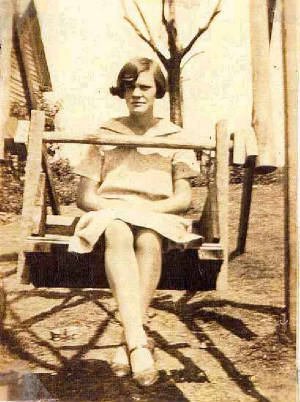
Aunt Sue Ann sitting in the seat of a Ferris wheel that Uncle Tom made.
(Go to Wes Tom's History to see some of Uncle Tom's photography.)
Uncle Tom was into photography, taking pictures and developing them. He never did get it just right
but he did make some dim pictures. He also made movies by hanging a sheet on the back wall of the hall. This was the screen.
Then he set his homemade projector outside in the sunlight. In the beginning the pictures were upside down, but he fixed that
by using an extra mirror. He once made a Ferris Wheel. He went to the woods and cut long poles to build it. It looked and
worked something like a real Ferris wheel but it did not have a motor. So we would tease Billy, our pet goat, then run and
jump in one of the seats. Billy would butt the back of the seat, and that would make it go around. When the next
seat came by the person in it would continue to tease him and he would butt the back of it and kept it going.
James Allen's (Uncle Jim's) wife Vella, contracted tuberculosis and he brought her back home so Granny
could take care of her. Granny was glad to help her. She put her in the east bedroom and made all the others stay
out. She bathed her, took all of her meals to her and read to her. She washed all of her clothes and bedding using strong
lye soap and boiled them in the wash pot. In spite of her loving care, Aunt Vella died. I believe she is buried
in the Lake Creek Cemetery.
After Aunt Vella died Uncle Jim went to North Dakota and worked on a farm. When he came back he had
quite a lot of money and he bought farm in Craddock, Texas, northwest of Paris. In 1928 he came to Granny and told her
he was going to lose the farm because he didn't have enough money to pay the taxes. At that time if a family was living on
a farm it could not be sold for taxes. I guess one man was not considered a family. He convinced Granny to move
to the farm until he could get the tax money so it would not be sold. Granny was not overly thrilled about it but she would
do what she thought was best for one of her young ones.
So we hitched the horses to the wagon and loaded it with all we
could, some furniture, clothing and things we needed most and started on the thirty mile trip to Craddock. We also
tied some of the farm animals to the back of the wagon. There was Granny and her children: James Allen, Wes Tom, Sue
Ann, Naomi, Harvena 'Red' and her granddaughters Vivian (me) and Mary Louise. We must have attracted a lot of attention.
By then most everyone went by car or truck down the highway. However, a few people still went by wagon at this time.
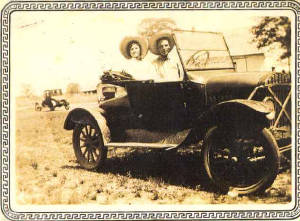
Craddock is where Naomi Johnson met Everett Cain.
Naomi (Nancy) Johnson, & Everett (Happy) Cain. The picture was
taken in Craddock, Texas shortly before they were married.
We were there for one year but as it turned out it was a very good move in many
ways. There in Craddock is where Wes Tom met Opal Nell Stone. She was the daughter of Kenny Shelton and Nellie Stone. The
Stone family were close neighbors to the Miller family. Nell was a good friend to Jessie Miller, their daughter. James Allen,
Uncle Jim, and Jessie started dating (in those days they called it courting) and were later married. Also when we
lived in Craddock Naomi met Everett 'Happy' Cain and they soon married.
Aunt Naomi 'Nancy ' and Aunt 'Red' always had true story magazines, but they kept them hidden from Mary Louise
and me because they were romantic stories about a boy and girl hugging and kissing and falling in love. Later
they had a baby. Usually the girl had the baby , then the fellow said good-bye and left the poor girl
alone. Well, you know, Mary and I found the Romance Magazines and read them. One night
Happy brought Aunt Nancy home and I saw them kissing in the hall. I couldn't sleep that night. The next morning I
said to Granny, "I am so sorry to have to tell you this but Aunt Nancy is going to have a baby." "No she isn't,"
replied Granny, "She's not even married! Why do you think she is going to have a baby?" I answered, "Because I saw Happy
kissing her last night!" Granny laughed and told me not to worry about it. I soon learned that it took more than
a kiss to make a baby. I was only ten years old then and we were not as well informed about sex in those days as
kids are now.
After we had been in Craddock for a year we loaded the wagon and moved back to Granny's home in
Lake Creek. This was in 1929, the year the stock market crashed, sending the country into the Great Depression. Immediately
the economy collapsed and in most of the nation there were no jobs. The jobs that could be found only paid about one
tenth of what they paid before. The depression hit Granny and her family hard and we had to depend on government
food supplement programs. She or one of her older children would go to Cooper to get the groceries that were allotted them:
sugar, chocolate, mustard, canned meat, flour, beans and other staples.
That same year 1929, Granny's daughter Sue Ann got married. She married a man named Everett 'Cook' Flowers
and they lived with Granny. Also that same year in August, 1929, Granny's sister Cuma died. As I said earlier, Cuma
and her two sons Johnny and Calvin had moved back to the Wilson home after her husband, Charles Skeen, died. Cuma was found
hanged by her neck with a piece of cloth tied to the high bedpost. Her death was ruled a suicide by the authorities, although
some family members and some of the neighbors believed that she was murdered. Cuma had short arms, just to the elbows, and
not much in the way of hands, just stubby fingers on her elbows and she could not have positioned herself that way.
Winnie and Pat still lived in the Wilson home. (They lived there until shortly before they died. Pat died
October 16, 1971. Winnie died January 16, 1977. Winnie had received the homeplace as part of her inheritance).
The authorities asked Pat if he and Winnie would like to keep Johnny and Calvin and raise them. Pat said,
"I will take Johnny since he is old enough to work, but Calvin is too young to do much work and will only be a burden to me."
So they gave Johnny to them and sent Calvin to an orphanage until he was twenty one years old. Johnny tried hard to please
Pat and worked hard for him. Uncle Tom believed Pat took unfair advantage of him and made him work too hard.
Aunt Sue Ann and Cook's first child was born August 27, 1930, a girl and they named her Katie Bell Flowers.
On July 10, 1931, Uncle Tom Johnson and Nell Stone got married. They did not have a place of their own
to live so they lived with Granny. The following year November 25, 1932, Sue Ann and Cook had their second child, another
girl and they named her Mary Ann Flowers. We all still lived at Granny's house.
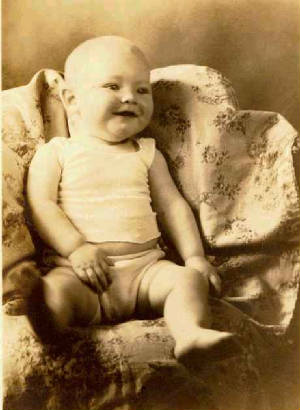
Earl Johnson
The next year 1933, Uncle Tom and Nell had their first child, a boy and they named him Lloyd Earl
Johnson. They still lived with Granny but Nell desperately wanted them to have their own place because she
and Granny did not get along very well. It seemed that Granny wanted to do everything for Uncle Tom as she
had always done, but Nell felt left out because she could not do for her husband as she pleased because it was Granny's
home.
On June 23, 1935, Aunt Sue Ann and Cook had their third child, a boy Everett Lee who was born dead.
The next day Sue Ann also died. Cook let Granny take Katie Bell and Mary Ann into her home and raise them. Granny did
so gladly, and raised them until they were grown and married.
In those days the Sulphur River (the dividing line between Delta and Lamar Counties) had not been
dug out and widened. When it rained a lot the river would overflow and flood the bottom land. If Pat's cows were in the bottom
land when it flooded he would send Johnny on horseback to get them. Uncle Wes Tom worried when his friend Johnny had
to go into the flood water, for there were many unseen ditches, holes and other objects the horse might encounter and Johnny
was not a good swimmer. On one such occasion Pat sent Johnny to get the cows. Later the horse returned without him. Pat called Uncle
Tom and some of the neighbors to go look for him. They looked until dark then called off the search until morning.
At daylight the search resumed and a call went out to all the surrounding communities for men who
had boats to come, for the water was too swift in places for men on horseback. Uncle Tom used to tell this
story saying, "So many boats came. I didn't know there were that many boats in the area." He said that
the water was deep in places so the men took long poles and put hooks on the end and drug the bottom for Johnny's body. Uncle
Wes Tom fashioned such a device and joined the search in one of the boats. The search lasted three days and they pulled
many logs, tree limbs and other debris but did not find his body.
It was getting late on the third day and many of the men took their boats and went home. Uncle
Tom asked some of the men to stay a little longer as he just couldn't leave his friend in that cold, muddy water.
In a short time Uncle Tom hooked something and when he pulled it up it was Johnny. He said that as he was pulling it
up he knew it was Johnny before he saw him. When Uncle Tom talked about it, he seemed to blame Pat for Johnny's
death and he probably had a right to do so. Johnny drowned May 12, 1935 and was buried in the Lake Creek Cemetery.
By now I had grown up and went away to college.
By now Nell really wanted to move away from Granny's house because they just couldn't get along
at all, but the depression had put a real crunch on their finances. The bales of cotton were only bringing about ten cents
a pound, about fifty dollars a bale. Before the depression it was bringing ten times that much. Uncle Tom still
worked at the gin in the fall after the farm work was done and made about a dollar a day. Still they were able to save
a little money, hoping to get enough to find them a place to move.
One day after Nell had a big fuss with Granny she came to Uncle Tom crying and said,
"I've got to get out of this place before I go crazy! I'll be willing to live anywhere." Uncle Tom said to her,
"We haven't saved enough money to buy a place of our own, but we could rent The Old Place from my mother and build
a log house on it. That's the best we can do at this time." Well, to say the least, Nell was overjoyed and they began
making preparations to build it. They didn't want to spend any money on rent so they made a deal with Granny to give her one
fourth of the money from the crops, and she was pleased with this. (I imagine Granny was ready for Nell to get out of
her house).
They decided to build the log house just in front of the old house, now fallen down. Evert Cain and
Naomi had lived in that house and their first child, James Wessley was born there. That way they could remove the debris from
the old house later. The farm was only fifty acres; twenty acres of cotton land, fifteen acres of cow pasture land, nine acres
of hay meadow and the rest was woods. The woods and part of the pasture were bottom land, part of the North Sulphur River
bottom land that flooded when the river overflowed. Granny told them they could cut all the logs they wanted from the woods
to build the house and for firewood. Uncle Tom and Nell counted
their money and priced building materials for the house. They decided there was enough money to buy two doors, two windows,
nails, lumber for the rafters, ceiling and floor. The rest they would have to cut from logs. Even the shingles for the roof
had to be cut from logs by sawing them into short blocks and slicing them with an ax.
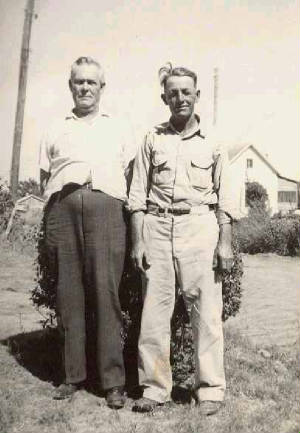
Kenny Shelton 'Pa'
Stone and Wes Tom Johnson.
They worked together and built two log houses, one for each of them.
Uncle Tom told Nell he would need help cutting the logs, for they had to be cut by hand. He had a long
saw for cutting down trees called a crosscut saw. It took two men to use it, one man on each end of the saw. Nell said
she would write her father, Kenny Shelton Stone, who still lived in Craddock to come and help. Both he and Nellie (Earl called
them Big Mama and Pa) were excited about them getting a new log house, and they came to see them. Nell convinced
them to move here and build a log house for them also. Granny told them it would be alright for them to build two log houses
on the land.
Soon they started cutting the logs and dragging them from the woods with mules. It was hard work
for them and Pa was close to sixty years old at this time. Finally the two houses were finished; both of them only had one
room. Uncle Tom and Nell's house had two windows in the front, a front and back door, each with screen doors. The
ceiling and floor were made from new lumber. Pa and Big Mama did not have much money and very little was spent on their house.
It had a hard-packed dirt floor, but Big Mama kept it swept with a broom. There was only one door and one window. The window
did not have any screen or glass in it, just shutters made from old boards. When the shutters were closed it was dark, even
in the daytime, so they lit a coal-oil lamp. The door was also made from old boards, probably from the old fallen down house.
Even the rafters were made of poles.
Earl was about two years old when they moved into their new house; that was in 1935,
the year Johnny Skeen drowned. Earl can't remember living at Granny's, but he remembers sitting on the front
step of their new log house and Nell taking his picture, he was probably about three years old. Nell
was so happy when they moved in, she made curtains for the two windows and did many other things to make the house pretty.
They were as proud of it as if it had cost a million dollars. However, the depression was not over yet, but Nell and Uncle
Tom were hard-working, young and energetic. They were determined to make their new life a success, as they
looked toward the hard times ahead and faced an uncertain future.
|

